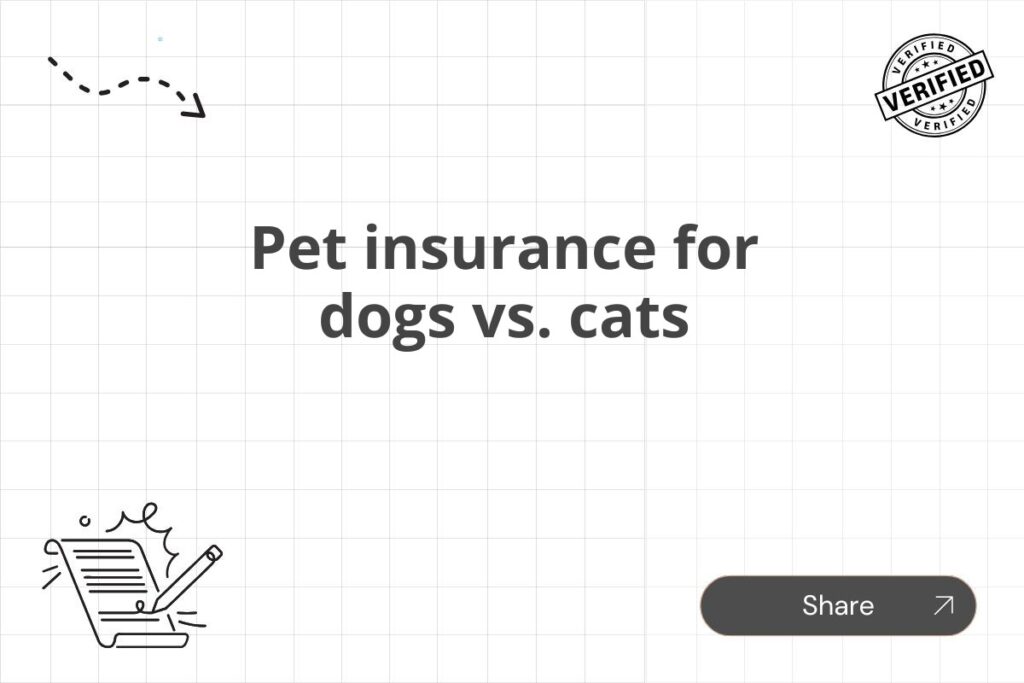Meta Description: Dog vs. cat pet insurance? We break down the key differences in coverage, costs, and common conditions, helping you choose the best policy for your furry friend. Learn more and find the perfect fit today!
Choosing the right pet insurance can be a daunting task, especially when weighing the options for your canine companion versus your feline friend. While both dogs and cats benefit from the financial protection offered by pet insurance, there are significant differences in the types of coverage they typically need, the associated costs, and the prevalence of certain health conditions. This comprehensive guide will delve into the nuances of pet insurance for dogs versus cats, helping you make an informed decision that best suits your pet’s individual needs and your budget.
Understanding the Basics of Pet Insurance
Before diving into the specifics of dog versus cat insurance, let’s establish a fundamental understanding of what pet insurance entails. Pet insurance, much like human health insurance, helps cover the costs associated with veterinary care for your pet. This can include expenses related to accidents, illnesses, and routine preventative care (depending on your chosen policy). Policies typically reimburse a percentage of the veterinary bill, often after a deductible has been met. Understanding the different types of coverage is crucial:
Types of Pet Insurance Coverage:
- Accident-Only Coverage: This covers only injuries resulting from accidents, such as broken bones or lacerations. It generally excludes illnesses.
- Accident and Illness Coverage: This is the most comprehensive type of coverage, encompassing both accidents and illnesses, offering broader protection.
- Wellness Plans (Optional Add-ons): Many insurers offer optional wellness plans that cover routine preventative care, such as vaccinations, parasite prevention, and annual checkups.
It’s important to note that pre-existing conditions are usually excluded from coverage. This means any health problems your pet had before the policy started will likely not be covered.
Pet Insurance for Dogs: Specific Considerations
Dogs, with their energetic nature and diverse breeds, face a unique set of health risks. Therefore, their insurance needs often differ from those of cats.
Common Health Issues in Dogs Requiring Insurance:
- Hip and Elbow Dysplasia: These hereditary conditions are common in certain breeds, leading to significant veterinary expenses.
- Cruciate Ligament Tears (ACL): A frequent injury in active dogs, often requiring surgery.
- Cancer: Canine cancer is prevalent, and treatment can be extremely costly.
- Bloat (Gastric Dilatation-Volvulus): A life-threatening condition requiring immediate veterinary intervention.
- Dental Disease: Regular dental care is essential, and dental issues can accumulate high veterinary bills.
Given the higher risk of these conditions and the potential for higher veterinary costs associated with their treatment, dog insurance premiums are often higher than those for cats. Breed, age, and location can also significantly influence premium costs. Larger and more active breeds tend to have higher premiums due to a statistically increased risk of injury.
Pet Insurance for Cats: Specific Considerations
While cats may seem less prone to injury than dogs, they are susceptible to their own set of health problems that can lead to substantial veterinary expenses.
Common Health Issues in Cats Requiring Insurance:
- Hyperthyroidism: A common hormonal disorder in older cats.
- Diabetes Mellitus: Requires ongoing management and medication.
- Kidney Disease (Chronic Renal Failure): A progressive and often expensive condition to manage.
- Feline Lower Urinary Tract Disease (FLUTD): This can range from mild discomfort to life-threatening blockages.
- Feline Infectious Peritonitis (FIP): A serious and often fatal viral disease.
Although cats generally have lower premiums than dogs, the costs associated with treating feline illnesses can still be substantial. While certain breeds may have a predisposition to specific conditions, age plays a significant role in determining the likelihood of developing health issues and influencing premium costs.
Comparing Costs and Coverage
The cost of pet insurance varies significantly depending on several factors, including the type of policy (accident-only versus accident and illness), the pet’s breed, age, location, and the deductible and reimbursement percentage chosen. It’s crucial to obtain quotes from multiple insurers to compare options and find the best value for your needs.
Generally, accident and illness coverage for dogs tends to be more expensive than for cats, reflecting the higher likelihood of injuries and the potentially greater cost of treatment for canine conditions. However, the actual cost will depend on individual factors mentioned above. Always carefully review the policy documents to understand what is covered and what is excluded. Consider factors like reimbursement percentages, annual limits, and waiting periods.
Choosing the Right Pet Insurance: Key Considerations
Choosing between pet insurance for dogs versus cats, or deciding whether to purchase insurance at all, is a personal decision. Factors to consider include:
- Your pet’s breed and health history: Certain breeds are predisposed to specific health problems, influencing the need for comprehensive coverage.
- Your budget: Pet insurance premiums can vary significantly, so it’s important to find a plan that fits your financial capabilities.
- Your pet’s lifestyle: Highly active dogs may require a policy with robust accident coverage.
- Your comfort level with potential veterinary expenses: Consider your ability to handle unexpected large veterinary bills.
Ultimately, the decision of whether or not to get pet insurance and which type of policy to choose is a deeply personal one. Weighing the potential costs of veterinary care against the monthly premiums is crucial. By understanding the specific health risks associated with your pet’s species and breed and researching different insurance providers, you can make an informed choice that provides the best possible protection for your beloved companion.
Remember to always read the fine print of any policy before committing. Contact multiple providers for quotes and compare plans side-by-side to ensure you’re getting the best coverage at the most reasonable price. Your pet’s health and well-being are worth the investment.






















